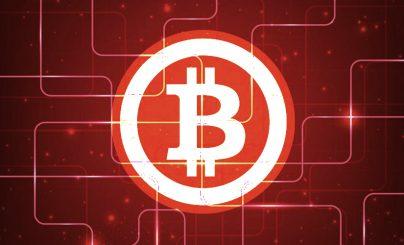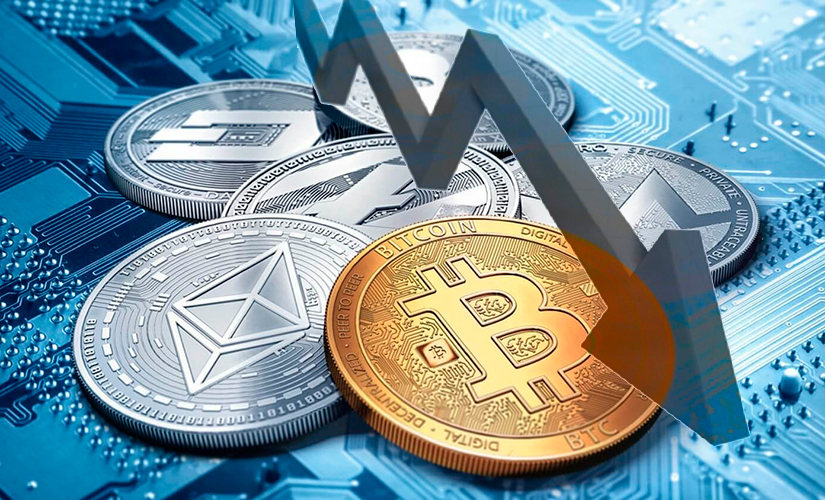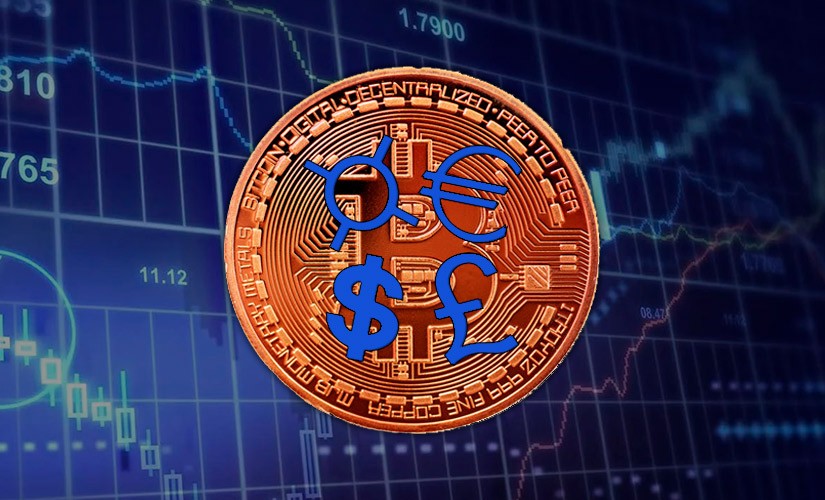Blockchain technology can improve the monetary settlement system by offering faster and more transparent payments. But it has its peculiarities. Sometimes cryptocurrency transfers are delayed – due to high network load or other factors. This article will tell you what to do if a bitcoin transaction hangs. There are several ways to speed up the payment.
What is an unconfirmed bitcoin transaction
The security of the Bitcoin network is provided by miners. They provide the computing power to verify, validate, and complete transactions into blocks. The miners are rewarded for their work – found BTC coins and network fees.
New payments go into a mempool (the memory of a network node) where they wait to be processed. They are called unconfirmed. Miners are interested in profit, so they first verify transactions with high fees and low weight. The others wait their turn to be processed.
As the network grew, the number of bitcoin transfers far exceeded the amount that miners could fit into a block. Mempool queues began to grow and lists of unconfirmed transactions appeared in blockchain browsers.
Why a BTC transaction can hang up
Bitcoin developer Satoshi Nakamoto limited the size of blocks on the blockchain to 1 megabyte (MB) to prevent DoS attacks. This is enough to accommodate approximately 2,400 medium-sized transactions (420 bytes). As cryptocurrencies became more popular, it became clear that the network could not handle the volume of transfers.
5020 $
bonus for new users!
ByBit provides convenient and safe conditions for cryptocurrency trading, offers low commissions, high level of liquidity and modern tools for market analysis. It supports spot and leveraged trading, and helps beginners and professional traders with an intuitive interface and tutorials.
Earn a 100 $ bonus
for new users!
The largest crypto exchange where you can quickly and safely start your journey in the world of cryptocurrencies. The platform offers hundreds of popular assets, low commissions and advanced tools for trading and investing. Easy registration, high speed of transactions and reliable protection of funds make Binance a great choice for traders of any level!
After the SegWit update, the concept of “block size” was replaced by “weight”. The figure itself has been increased to 4 MB. In 2024, the average block weight is 1.5-1.7 MB.
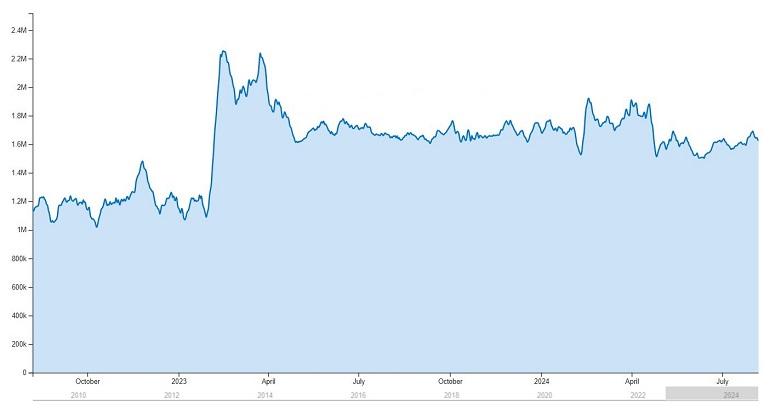
Segwit integration partially offloaded the network and reduced commissions. However, the principle of processing transfers remained the same. The Bitcoin blockchain is scalable. During periods of network activity, the number of transactions can exceed the capacity of miners. This leads to delays in confirmations.
What affects the speed of transactions in the blockchain
Mempool size indicates how fast the network is. A large number of unconfirmed transfers is a frequent cause of a bitcoin transaction hanging. Since transactions are verified on the blockchain, new ones will not enter the blockchain until the previous ones are processed.
The speed of transactions is also affected by a combination of factors:
- Network congestion.
- The fees that users are willing to pay to transfer funds quickly.
- Technical problems with the blockchain can lead to errors in the distribution of payments to nodes or when they are included in the blockchain.
- Internal conflicts (including the emergence of forks) can create uncertainty in bitcoin transactions and lead to delays.
Network congestion
During periods of high Bitcoin exchange rate volatility, activity within the blockchain increases. As many transfers with high fees prioritized by miners appear, the execution of less profitable transactions is significantly delayed.
Current network traffic can be monitored on analytics platforms – for example, Blockchair.
In addition, bitcoin transactions can get lost in the network. This happens because nodes have different settings. Some delete transfers that have not been confirmed within 2-3 days. Others do not accept transactions with too low fees.
Fees
According to Blockchain.com, in August 2024, the Bitcoin mempool receives an average of 1.05 billion transfers per day. During this time, miners validate 548 thousand transactions. The average processing time for each is 147 minutes. Users interested in fast payment processing have to pay a higher commission. The rest are waiting for the next block to be created.

In the main cryptocurrency’s blockchain, it takes 10 minutes. However, a transfer can take 1-1.5 hours or more. Transactions with a small fee remain unconfirmed until the network load is reduced.
Some bitcoin wallets (Bitcoin Core) can increase the fee to speed up the transaction.
Others (Coinbase) calculate network fees using built-in mechanisms that are not disclosed. This incentivizes miners to select transactions with higher fees for prioritized processing. Ultimately, it is up to them to determine how soon the bitcoins end up in the recipient’s wallet.
Payment amount
The amount of BTC coins sent does not directly affect the speed of verification in the blockchain. But wallets that use their own mechanisms for calculating commissions often increase them for large amounts. This allows to speed up the passage of the transaction.
For example, in Guarda Wallet, when sending 0.00001 BTC, the network fee is 0.0000174 coins ($1.04). If you increase the transaction amount to 0.0001 Bitcoin, the fee will automatically increase to 0.0000258 BTC ($1.54).
What to do if a bitcoin transaction hangs in the blockchain
When making a payment in BTC, you need to accurately calculate the amount of the network fee. This will help avoid the situation when a bitcoin transaction hangs in the blockchain. Exchanges usually set a default average payment. In many wallets, users can change the network fee manually.
If the crypto transfer has gone into the blockchain and is taking a long time to process, the options are as follows:
- Wait for miners to prioritize transactions and move on to the rest. This can take hours or days.
- Wait for the transaction to be canceled. This can happen when most nodes do not accept or delete the transaction. The coins are then returned to the sender.
- Independently “push” a Bitcoin transfer. Several methods can be used to do this.
Methods of accelerating BTC transactions
If a bitcoin payment is not displayed in all browsers, it is recommended to send it again. You need to copy the hash or command line format (raw tx) and resend it manually using the broadcast option in browsers or payment platforms. This option is available on Blockchair, Blockstream, Bitpay and other platforms. Nodes will verify the BTC transaction and add it to the blockchain.
There are various techniques – paid and freely available – to speed up transfers. Some can be used by both senders and receivers.
Replace-By-Fee
This is a dynamic change of the fee amount in a sent Bitcoin transaction. The option is supported by popular wallets Electrum, Bitcoin Core, and Samourai Wallet. When RBF is activated, the user sends a signal to the blockchain that they are willing to pay more if the BTC transaction hangs up. The miners will automatically accept the new cryptocurrency in place of the old one.
In some wallets, 2 or more transactions can be combined at the same time as the fee increase to save money. This is the kind of feature that Exodus offers.
When a network fee is changed, a new crypto transfer is not created. Instead, the nodes receive additional information on the sent transaction. Therefore, there is no risk of double spending.
Increasing the size of the fee
It is better to take care in advance that the BTC transaction does not hang in the mempool. Before executing the transaction, you can look in the browser at the current state of the network and the size of the commission. If the network is overloaded, you should slightly increase the payment to miners. This will ensure priority fulfillment.
In 2024, many bitcoin wallets use built-in mechanisms for calculating the commission. Manual selection is supported by several popular vaults – you can compare them in the table.
| Bitcoin wallet | Date of creation (year) | By type of private key storage | Available on platforms |
|---|---|---|---|
Wallet Export
If the vault doesn’t allow you to manually increase the fees to miners, you can integrate it with a more functional interface – like Exodus. The instructions are as follows:
- Authorize in the Exodus personal account on PC, in the mobile app or on the website.
- Click on the “Create a new wallet” button.
- Think up and enter the name of the storage. Click on “Next”.
- Select “Standard Wallet”. Click on the “Next” button.
- Go to the “I already have a seed phrase” section.
- Enter the secret words.
After that, you can manage your cryptocurrency assets in the Exodus interface. This includes sending funds and increasing network fees are available.
Payment Accelerators
If the browser shows the status of the transaction “Waiting on the blockchain”, you can “promote” it with the help of special programs or websites. Among the free gas pedals are known:
- biaAccelerate – does not require registration and notifies from which addresses the payment was broadcast.
- bitTools – works anonymously, sends a transfer every 6 hours until confirmation.
- bitNitro – free version works with public nodes. For $25, the transaction goes through the mining pool without waiting.
Paid gas pedals are faster, as miners receive additional financial incentives to prioritize bitcoin transfers for verification. AntPool, ViaBTC, and BTC.com pools typically offer this service.
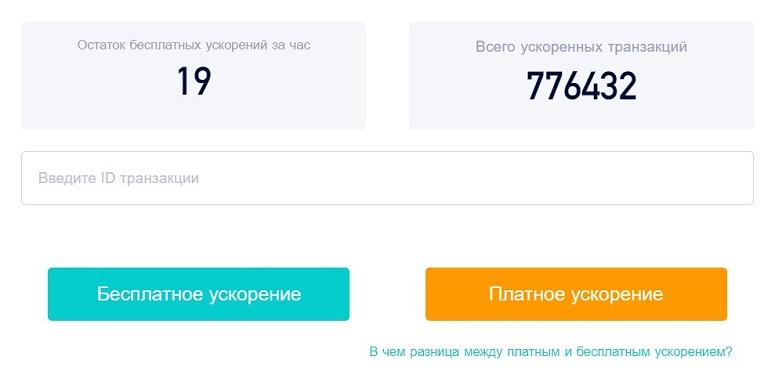
BTC.com increases the probability of being added to the block by 75% within an hour and 98% within 4 hours. You can pay for the service with any supported cryptocurrency. You can start the acceleration in the following way:
- On the pool’s website, select the “Tools” section, then select the Txn Accelerator (CPFP) option.
- In the gas pedal window, enter the transaction hash. Click on the “Next” button.
- The program will calculate the price of the service. You need to select the payment method and click on “Confirm”.
Child Pays for Parent
This method will help to speed up a hung Bitcoin transfer with a low fee. Child Pays for Parent translates as “Child Pays for Parent”. It works like this:
- The recipient sends a new Bitcoin transfer with unconfirmed coins to the network, but sets the network fee higher than the previous one.
- Miners are signaled that to confirm the new transaction, they must first verify the associated previous transaction. The fee on the second transaction will cover the addition of both to the blockchain.
The CPFP option is supported by a limited number of wallets. Among them are Electrum, Exodus, Trezor. The algorithm of actions is as follows:
- Open the Wallet section.
- Activate Spend unconfirmed change and Enable coin features.
- Click the Send button.
- Go to the Inputs tab.
- Enter your address in the “Recipient” field.
- Enter the amount of the pending transaction and check the subtract fee amount box.
- In the Custom field specify the fee to miners for 2 transactions.
- Confirm the transaction by clicking the Send button.
Increasing payment priority
To speed up the transaction verification, you need to promote it to the top of the list in the mempool. There are several ways to do this:
- Transfer large amounts, setting the fee higher than average. Small payments with standard fees are checked last.
- Use digital signatures. This indicates the reliability of the payment.
- Send digital currency using a trusted server that will provide visibility of the payment to outside observers.
Frequently Asked Questions
⛏ How do I cancel a Bitcoin transaction?
Transfers on the Bitcoin network are irreversible. It is impossible to cancel a confirmed transaction. But there are ways that allow you to cancel a transaction unverified by miners.
➗ What other programs can help speed up a transaction on the Bitcoin blockchain?
You can use ConfirmTX, 360 Bitcoin Accelerator, BitAccelerate and other services.
🙅♂️ What is the Lightning Network?
It is a second-tier Bitcoin network. Since transactions are not conducted on the main blockchain, there is no need for queues and high fees.
👤 How is the fee calculated?
You need to multiply the weight of the transaction by the price of transferring one byte in satoshis. The cost of a byte increases with increasing activity on the network.
👨💻 Are there any risks of using paid gas pedals?
Yes. There are fraudulent services among such services. It is recommended to look at reviews of gas pedals on forums and independent sites.
Is there a mistake in the text? Highlight it with your mouse and press Ctrl + Enter.
Author: Saifedean Ammous, an expert in cryptocurrency economics.
